In a WhatsApp audio message, schoolteacher Claudionor Tamuxi Iranxe gives directions to the Manoki people’s indigenous land: after crossing 100 kilometres of endless fields of agricultural crops beside the BR-364 highway, there will be “a large expanse of cerrado [Brazilian savannah] woodland”. “That’s our territory,” he says.
Living at the border between cerrado and the Amazon forest, in the municipality of Brasnorte (586 kilometres Northwest of Cuiabá), the Manokis almost disappeared after first coming in contact with whites. But their numbers have begun growing again over the last few decades and while they fight to recover their original territory, they have become one of the indigenous people who have resorted to soybean production for income.
Growing soybeans and other large mechanized crops has become the main proposition for indigenous peoples under far-right president Jair Bolsonaro, who has historically opposed land demarcation and has even tried to revoke some indigenous land rights, which cover about 13% of Brazil’s territory.
Bolsonaro’s policy has raised fears that opening indigenous territories to large scale crop cultivation will increase deforestation. Indigenous territories have only a 2% deforestation rate. They are better preserved than all categories of protected areas, including national parks.
Fierce opponents of Bolsonaro’s, the Manokis claim that it is possible to reconcile mechanized agriculture with conservation.
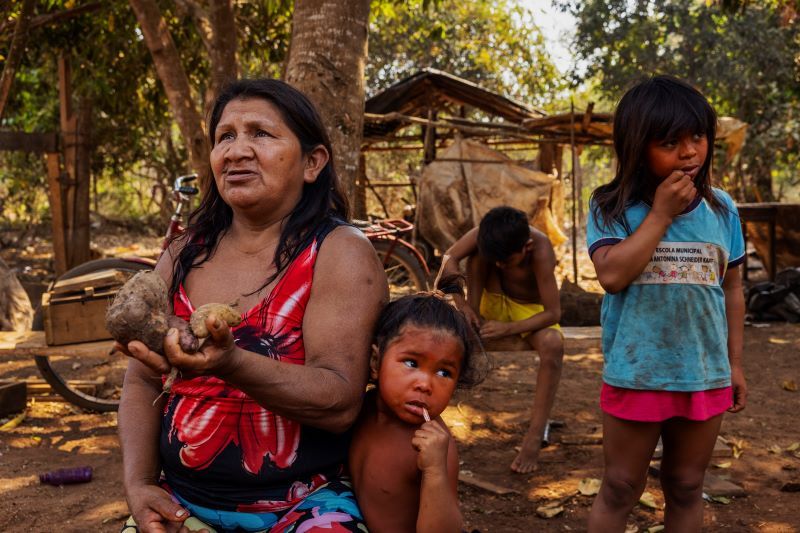
Surrounded by her grandchildren, Lucibete Iurici shows us the root vegetables she grows (All photos: Lalo de Almeida/Folhapress)
The Manokis’ incursion into the production of Brazil’s major agricultural commodity began in 2004, after a decision taken jointly with the Parecis, a neighbouring indigenous people. That year the Manokis cut down 1,000 hectares of cerrado, equivalent to 2.2% of their territory. Now, 17 years later, the expanse of land they cultivate has not changed. It is the opposite of what happens on neighbouring fazendas (large plantations), where practically no native vegetation remains.
For years the Manoki, Parecis and Nambikwara flouted the law to grow soybeans. In addition to not having environmental licensing, the land was leased to fazendeiros (large plantation owners), and genetically modified crops were grown. Both of these practices are forbidden by legislation on indigenous lands.
This continued until December 2019, when the Coopihanama cooperative, involving the three peoples, and the Coopermatsene, belonging only to the Parecis, signed a TAC (Adjustment of Conduct Agreement) with the MPF (Federal Public Prosecutor’s Office) to regulate mechanized farming in their territories.
Among other things, the cooperatives undertook not to lease out their lands nor plant genetically modified crops and to seek funding from official institutions. Indigenous affairs agency Funai and environmental regulator Ibama subscribed to the agreement.
“It is a project we want to take to the entire country, so that this way they (the indigenous peoples) can gain income and greater dignity,” said the president of Funai, Federal Police chief and former advisor to the landowners’ caucus in Congress Marcelo Xavier. His speech can be found in a Funai institutional video filmed in April inside a rice harvester, alongside a Bakairi indigenous person, in Mato Grosso state.
Unlike their Parecis neighbours, whose leaders often appear in public beside Bolsonaro in public and even on Facebook Live, the Manoki do not see the government as an ally. Far from it: in August they sent representatives to Brasília to protest against a court ruling in the government’s favour. participate in the camp of protesters following the judgement of the “marco temporal” (“time frame”) in the STF (the high court).
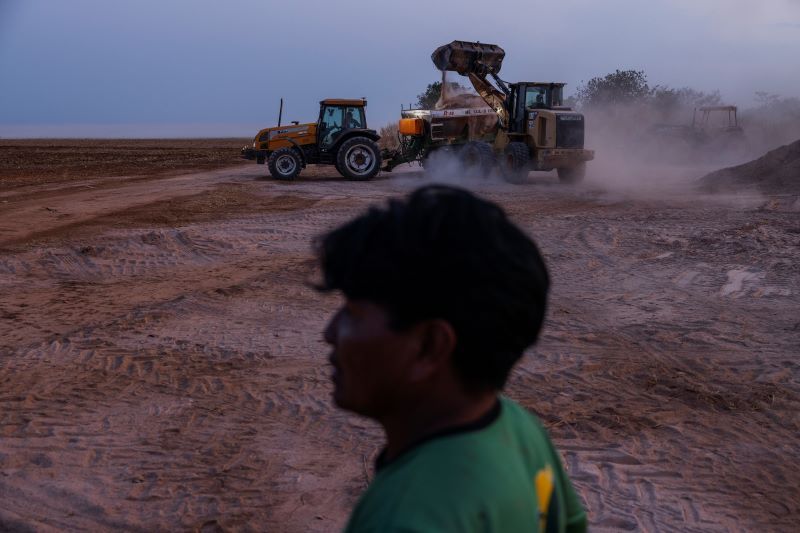
Manokis use tractors to spread agricultural lime and balance the soil in preparation for planting
From the Manoki’s perspective, the regularisation of mechanized farming came about as the result of a lengthy process of negotiation started by the region’s indigenous peoples under the Coopihanama cooperative.
“In my view, this is a crazy government that knows nothing about Indians’ life. On the one hand, it’s in favour of agriculture. But I’m not taken in by his words, no way,” says the chief of the Manoki, Manoel Kanunxi, 71. “I haven’t fought the president expecting him to give me support. I haven’t fought any candidate, deputy, senator, mayor or councilman.”
The Manoki say they don’t want to expand the deforested area. Neither do they engage in the white man’s agribusiness, they say. For them, mechanized farming, which this year has included off-season crops of corn, is the only way they have found to fund their medical expenses, transport and other needs created by contact with kewa [white people].
Their mechanized farming employs only four Manoki on a permanent basis, although this number goes up at harvest time. They learned to operate the machines working on neighbouring fazendas or taking courses. On the days when Climate Home News was at the site, they were spreading agricultural lime to balance the soil. The only white man present was a hired technician. For the Manoki, hiring a kewa employee is something to be proud of.
Last year their mechanized farming yielded R$ 700,000 ($12,800), which would be shared among the Manoki (a population estimated at nearly 500 individuals). The amounts allotted, approved in an assembly, were decided based on a calculation that includes each family unit and a per capita sum.
“I don’t eat soybeans. But we are putting these soybeans on the market so as to survive this way, so we can buy medicines and pay for private medical tests. We’ve found out that you have to pay for everything you use,” says Kanunxi.
The chief mentions his own wife’s treatment, which had to paid for with the income from soybeans – she needed a pacemaker in her heart. “It’s tough, but it has been worth it. If it weren’t for this, my wife would have died.”
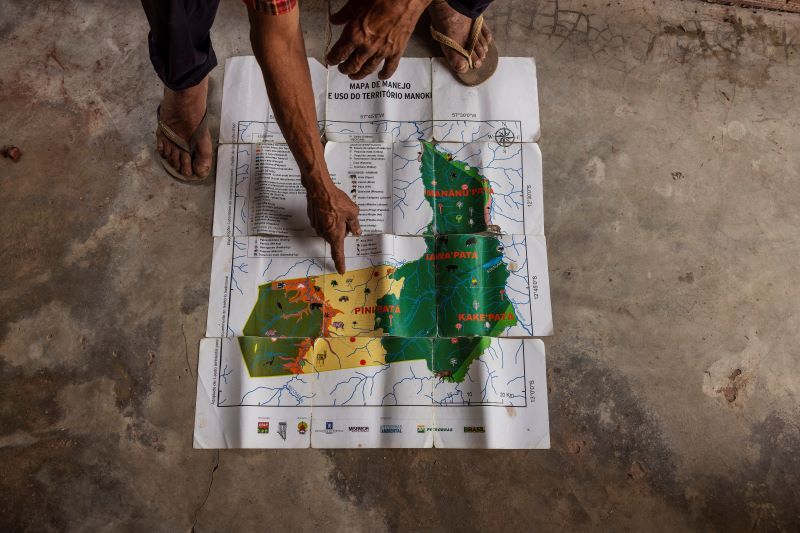
Chief Manoel Kanunxi, 71, shows a map of the Manoki territory
The main reason the Manoki are unhappy with Bolsonaro is the president’s refusal to demarcate Indian lands. This is the greatest priority for their people, who have been fighting for three decades to expand their territory by 206,000 hectares of forested area that is part of the Manoki’s traditional habitat.
The official decisions so far have favoured their claim, but it is a lengthy process. In 2009 the Justice Ministry published an ordinance ratifying the expansion, but its official recognition was never signed by the president, and landowners are currently contesting the expansion in federal courts.
On the days when Climate Home was in the indigenous land, the Manoki were following with apprehension the judgment in the “marco temporal” case in Brazil’s supreme court. Supported by Bolsonaro and the landowners’ caucus, the so-called “time frame” thesis is that only lands that were occupied by indigenous peoples in 1988, when the present Constitution went into effect, should be demarcated.
The indigenous peoples’ territorial claims are based on extensive historic documentation, including reports presented by Marshal Rondon (1865-1958), who collected information and documented the massacre perpetrated by rubber tappers against the Manoki in 1900, marking the beginning of their contact with whites.
“Can any Brazilian soul not tremble as one with ours on learning that the entire population of men, women and children was burned to death inside their huts set on fire?”, the military officer wrote in 1922, a few years after he led an expedition through the Amazon with US president Theodore Roosevelt
In the mid-fifties, after suffering from outbreaks of Korean flu, measles and typhus, besides attacks from neighbouring peoples – themselves pressured by the arrival of the rubber tappers – most of the Manoki, including Kanunxi, allowed themselves to be convinced by the Jesuits to leave their lands. They went to live in the Anchieta mission, beside the majestic Utiariti waterfall, in the land of the Parecis.
On the one hand, the Manoki were safe from their enemies and received medical attention. But the strict school system, which jumbled members of different peoples together and kept boys and girls apart, made the Portuguese language compulsory. This is why only the elders speak Manoki today.
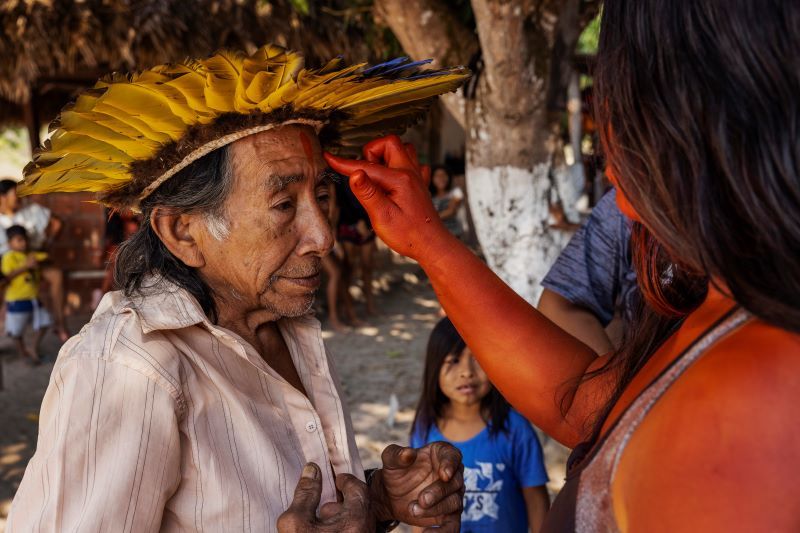
Young woman paints the face of chief Manoel Kanunxi, 71, before a cultural presentation of the Manoki people
In 1968 the Manoki moved to the Irantxe Indigenous Land, an area of 45,500 hectares demarcated that year. At the time their numbers were reduced to around 50 individuals.
This area lies on the left bank of the Cravari River, where the vegetation is mainly cerrado, but their traditional territory is on the right bank, covered in forest. This was not a problem to begin with, as they wandered all over the region.
But from 1969 three fazendas sprung up with funds subsidized by Sudam (Superintendence for the Development of the Amazon Region). According to the Brasnorte council, the region began to be settled on a large scale from 1978 onwards, with the arrival of families coming from the west of Paraná.
In a few short years, the Manoki found themselves hemmed in by soybean plantations and pasturelands. Of the territory they claim as their own, 40,700 hectares of forest have already been destroyed. One of the landowners cut down the forest right to the banks of the Cravari, close to two waterfalls that are sacred to the Manoki. He even built a small hydroelectrical plant on the site, without an environmental license. The plant was dismantled after pressure from the Indians.
Should the supreme court approve the “marco temporal”, the Manoki would lose the right to retake their traditional land. The judgment on the case has been halted indefinitely after a request for inspection made by chief justice Alexandre de Moraes.
“A people that doesn’t have a demarcated territory can’t live as a people. The struggle began with our grandparents, our great-grandparents. The ‘marco temporal’ is the destruction of the indigenous peoples. The government says we have to integrate with society. But we don’t need to integrate – we need to interact. If you integrate, you stop being who you are to live in a different way. You forget your language, your roots and your territory,” says schoolteacher Edivaldo Mampuche Manoki, 34.
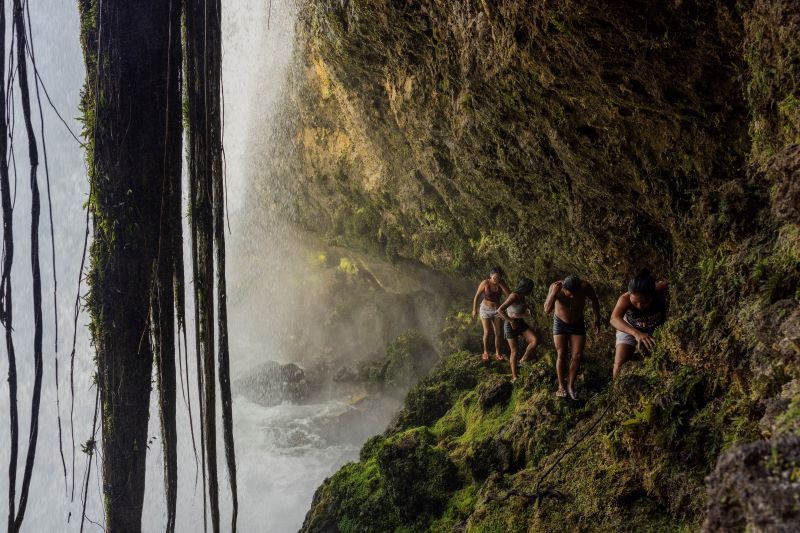
Young Manokis crossing under a waterfall of the River Cravari in the Irantxe Indigenous Land
Another problem for the Manoki was the construction of the Bocaiúva Small Hydroelectric Plant, in operation since 2010. Because of the dam, fish species such as pacu and matrinxã, which were part of the Manoki’s food supply, have disappeared from the Cravari.
“It has had a tremendous and irreversible impact,” says schoolteacher Claudionor Iranxe. “Of course there was compensation, but not enough to offset what it has done to our people’s traditional food self-sufficiency.”
Questioned about the impact, the company that controls the plant, Sileia Participações, said: “There is no technical basis to establish this cause and effect relationship, in other words, to say that the construction of the project has been the cause of the disappearance of species of the icthyofauna.”
The environmental degradation surrounding the plant forces the Manoki to travel tens of kilometres to hunt and fish, activities related to preparations for their traditional feasts. In many cases the landowners don’t allow them to enter these areas.
In their present territory, besides soybeans, the Manoki sow their traditional crops such as yams, bananas and potatoes, as well as having fruit trees and vegetable gardens. Almost all the preparation of the land in these areas is done by hand. They are also starting to produce honey and farm fish.
Many families produce handicrafts. A Manoki cotton hammock can take up to three months to make. And some of them work for the public sector in the education and health areas.
All the villages except one are located far away from the soybean plantation. Their houses, made of wood or cement, are simple and similar in style but have running water, electricity and connection to the internet.
“As far as I am concerned, I want to forget this crop [soybeans]. It is not going to feed our people. It will help occasionally when needed. But we can’t live off this crop,” says the president of the Watoholi Association, Paulo Sérgio Kapynxi, 52.
“What we need to do is grow things without poison, have our livestock, make manioc meal. When we have to pay for surgery or buy an expensive medication, then we’ll remember the plantation. But in the meantime, let’s forget it”.
This reporting is part of The Amazon under Bolsonaro, a collaboration between Folha De Sao Paulo and Climate Home News. The text was translated from Portuguese by Clara Allain. All photos by Lalo de Almeida.